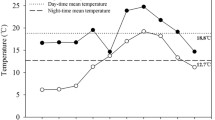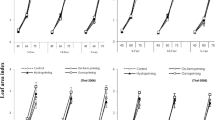Abstract
Transplanting is the major method of rice cultivation in the world, in which seedlings are raised in nursery and then transplanted into well puddle and prepared fields. The traditional nursery sowing method is tedious and produces week seedlings that reduce the final yield due to high mortality. The potential of seed priming to improve the nursery seedlings and thus the transplanted rice was evaluated in the present study. The experiment was conducted in the rice growing area (31.45° N, 73.26° E, and 193 m) of Pakistan, during 2004–2005. Seed priming tools employed during the investigation included traditional soaking, hydropriming for 48 h, osmohardening with KCl or CaCl2 (Ψs −1.25 MPa) for 24 h (one cycle), 10 ppm ascorbate for 48 h or seed hardening for 24 h. Priming improved the initial seedling vigor and resulted in improved growth, yield and quality of transplanted fine rice while traditional soaking behaved similar to that of untreated control. Osmohardening with CaCl2 resulted in the best performance, followed by hardening, ascorbate priming and osmohardening with KCl. Osmohardening with CaCl2 produced 3.75 t ha−1 (control: 2.87 t ha−1) kernel yield, 11.40 t ha−1 (control: 10.03 t ha−1) straw yield and 24.57% (control: 22.27%) harvest index. The improved yield was attributed due to increase in the number of fertile tillers. Significant positive correlation was found between mean emergence time of nursery seedlings and kernel yield, nursery seedling dry weight and kernel yield, fertile tillers and kernel yield, and leaf area duration and kernel yield.



Similar content being viewed by others
Abbreviations
- MET:
-
Mean emergence time
- HI:
-
Harvest index
- LAI:
-
Leaf area index
- LAD:
-
Leaf area duration
- CGR:
-
Crop growth rate
- NAR:
-
Net assimilation rate
- Ψs :
-
Osmotic potential
- RL:
-
Seedling root length
- SL:
-
Seedling shoot length
- FW:
-
Seedling fresh weight
- DW:
-
Seedling dry weight
References
Anonymous (2005) Economic survey of Pakistan, 2004–2005. Govt. of Pakistan, Finance Division, Economic Advisors Wing, Islamabad, Pakistan, pp 16–18
Basra SMA, Farooq M, Tabassum R (2005) Physiological and biochemical aspects of seed vigor enhancement treatments in fine rice (Oryza sativa L.). Seed Sci Technol 33:623–628
Chowdhary AQ, Baset QA (1994) Effect of soaking period and aerobic condition on germination of wheat seeds. J Chittagang Univ 18:83–87
Dell Aquilla A, Tritto V (1990) Ageing and osmotic priming in wheat seeds: effects upon certain components of seed quality. Ann Bot 65:21–26
Du LV, Tuong TP (2002) Enhancing the performance of dry-seeded rice: effects of seed priming, seedling rate, and time of seedling. In: Pandey S, Mortimer M, Wade L, Tuong TP, Lopes K, Hardy B (eds) Direct seeding: research strategies and opportunities. International Rice Research Institute, Manila, Philippines, pp 241–256
Ellis RA, Roberts EH (1981) The quantification of ageing and survival in orthodox seeds. Seed Sci Technol 9:373–409
Farooq M, Basra SMA, Kareem HA, Afzal I (2004) Optimization of seed hardening techniques for rice seed invigoration. Emirates J Agric Sci 16:48–57
Farooq M, Basra SMA, Hafeez K (2005) Thermal hardening: a new seed vigor enhancement tool in rice. J Integr Plant Biol 47:187–193
Farooq M, Basra SMA, Cheema MA (2006a) Integration of pre-sowing soaking, chilling and heating treatments for vigor enhancement in rice (Oryza sativa L.). Seed Sci Technol 34:189–196
Farooq M, Basra SMA, Hafeez K (2006b) Rice seed invigoration by osmohardening in fine and coarse rice. Seed Sci Technol 34:181–187
Farooq M, Basra SMA, Wahid A (2006c) Priming of field-sown rice seed enhances germination, seedling establishment, allometry and yield. Plant Growth Regul 49:285–294
Farooq M, Basra SMA, Khalid M, Tabassum R, Mehmood T (2006d) Nutrient homeostasis, reserves metabolism and seedling vigor as affected by seed priming in coarse rice. Can J Bot 84:1196–1202
Farooq M, Basra SMA, Afzal I, Khaliq A (2006e) Optimization of hydropriming techniques for rice seed invigoration. Seed Sci Technol 34:507–512
Hampton JG, Tekorny DM (1995) Handbook of ISTA vigour test methods, 3rd edn. ISTA, Zurich, p 10
Hunt R (1978) Plant growth analysis. Edward Arnold, London
Jett LW, Welbaum GE, Morse RD (1996) Effects of matric and osmotic priming treatments on broccoli seed germination. J Am Soc Hort Sci 12:423–429
Juliano BO, Onate LU, Mundo AM (1965) Relation of starch compaction, protein content and gelatinization temperature to cooking and eating quality of milled rice. Food Technol 19:1006–1011
Juliano BO (1971) A simplified assay for milled rice amylose. Cereal Sci 16:334–340
Kathiresan K, Kalyani V, Ganarethinam JL (1984) Effect of seed treatments on field emergence, early growth and some physiological processes of sunflower (Helianthus annuus L.). Field Crop Res 9:215–217
Khan AA (1992) Pre-plant physiological seed conditioning. In: Janick J. Hort (ed) Reviews, vol 14. Willey, NY, pp 131–181
Kurdikeri MB, Aswathaiah B, Mahadevappa M, Prasanna KR, Prasad SR (1995) Effect of seed invigoration on field performance of maize. Mysore J Agric Sci 29:208–212
Paul SR, Choudhary AK (1991) Effect of seed priming with salts on growth and yield of wheat under rainfed conditions. Ann Agric Res 12:415–418
Reddy S (2004) Agronomy of field crops. Kalyani Publishers, New Delhi, India
Shaw J, Beadle LC (1949) A simplified ultra-micro Kjeldahl method for the estimation of protein and total nitrogen. J Exp Biol 26:15–23
Thakuria RK, Choudhary JK (1995) Effect of seed priming, potassium and anti-transpirant on dry-seeded rainfed ahu rice (Oryza sativa). Indian J Agron 40:412–414
Watson DJ (1947) Comparative physiological studies on the growth of field crops. I. Variation in net assimilation rate and leaf area between species and varieties and between years. Ann Bot 11:41–76
Yamauchi M, Winn T (1996) Rice seed vigor and seedling establishment in anaerobic soil. Crop Sci 36:680–686
Zheng HC, Jin HU, Zhi Z, Ruan SL Song WJ (2002) Effect of seed priming with mixed-salt solution on emergence and physiological characteristics of seedling in rice (Oryza sativa L.) under stress conditions. J Zhejiang Univ 28:175–178
Acknowledgment
Authors acknowledge the Higher Education Commission, Government of Pakistan, for financial support of the studies.
Author information
Authors and Affiliations
Corresponding author
Rights and permissions
About this article
Cite this article
Farooq, M., Basra, S.M.A. & Ahmad, N. Improving the performance of transplanted rice by seed priming. Plant Growth Regul 51, 129–137 (2007). https://doi.org/10.1007/s10725-006-9155-x
Received:
Accepted:
Published:
Issue Date:
DOI: https://doi.org/10.1007/s10725-006-9155-x




